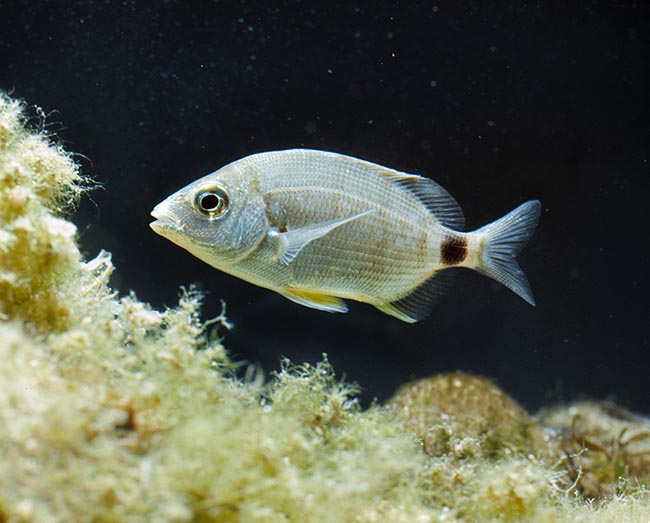Family : Sparidae

Text © Giuseppe Mazza

English translation by Mario Beltramini
Diplodus annularis is recognized at once for the black dot without white edge on the tail © Giuseppe Mazza
The Annular seabream (Diplodus annularis Linnaeus, 1758), belongs to the class Actinopterygii, the ray-finned fishes, to the order of Perciformes and to the family of Sparidae.
The name of the genus comes from the Greek “diplous” = two, and “odous” = tooth, therefore “double tooth”, with reference to the double incisors, particularly evident.
The name of the species comes from the Latin “annulus” = ring, due to the typical black annular spot just before the caudal peduncle, which is not, however, edged of white as is the case of the Saddle bream (Oblada melanura).
Zoogeography
It is present all over the Mediterranean, but does not abound in the Black Sea and between Egypt and Turkey. After Gibraltar Strait, it goes northwards along the eastern Atlantic coast up to Biscay Gulf, and, southwards, it reaches Morocco, colonizing Madeira and the Canary Islands.
Ecology-Habitat
At home in the ports, it lives along the coasts exploring the intertidal zone, but also swims, happily, in small schools or with other sparids in the grasslands of Posidonia (Posidonia oceanica). It almost never ventures down in deep waters, even if, after some, the old individuals might reach the 90 m. In spring, it often frequents also the brackish water of the lagoons.
Morpho-physiology
It is the smallest bream, with a record of 24 cm, and an average, depending on the zones, of 13-16 cm.
The mouth, relatively ample and protractile, has symmetrical jaws with 8 incisors followed by several rows of molars, for removing and chewing the small creatures living on the submerged rocks.

Closely tied to the tidal zone, often frequents the rocks seeking small crustaceans © Giuseppe Mazza
The dorsal fin is unique, formed by 11 spiny rays and 12-13 soft; the anal, about half long, contents of 3 spiny rays and 12-13 unarmed; the small ventral ones have one spine and the pectoral are long and pointed. The tail is forked.
The colour, bright silvery with a slight tendency to the yellow, gets more intense in the adults and reinforces with mimetic vertical dark bands when the animal is menaced.
In any case, the ventral and the anal fins are always more or less yellowish and even orange, but the most characteristic element, as mentioned before, is the black spot not edged of white towards the caudal peduncle.
Ethology-Reproductive Biology
As soon as the high tide occurs, our annular seabream goes around for checking the news standing amongst the rocks covered by seaweeds. It looks for crustaceans, molluscs and small echinoderms, without ignoring, if it’s the case, also some good little worm.
The mating season is quite variable, depending on the zones, because is related to the temperature of the water. Where it is warm, it reproduces also in January, but along the Italian coasts this will happen in spring-summer. The eggs are floating and are often carried offshore by the currents, so much that 15 mm larval forms, already recognizable by the black spot on the tail, have been found at even 10 km off the coast under floating seaweeds. The juveniles, when around 4 cm, do clearly exhibit the vertical bands of the defensive livery and, driven by the instinct, move towards the ports, the lagoons and the intertidal zone.
When about 9 cm long, at the puberty age, their sex is still uncertain: the gonad is ovarian on one side and testicular on the other. Then one of them gets the better and the other regresses. So, the sexes are separated, but some males reconsider this and, with the age, may become females. This is therefore, as the Gilthead seabream (Sparus aurata) a protandric hermaphrodite species.
The lifespan of an annular seabream is of 7 years. The vulnerability index of this species is of 27 over 100.
Synonyms
Sparus annularis Linnaeus, 1758.
→ For general information about FISH please click here.
→ For general information about BONY FISH please click here
→ For general information about CARTILAGINOUS FISH please click here.
→ To appreciate the BIODIVERSITY of BONY FISH please click here.
→ To appreciate the BIODIVERSITY of CARTILAGINOUS FISH please click here.
